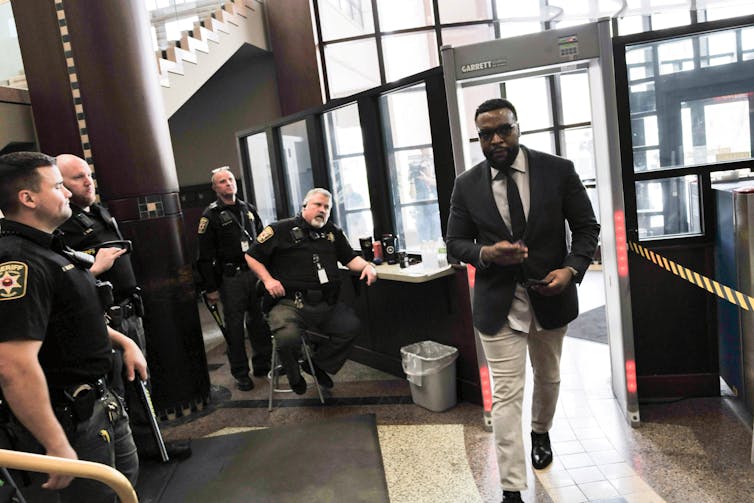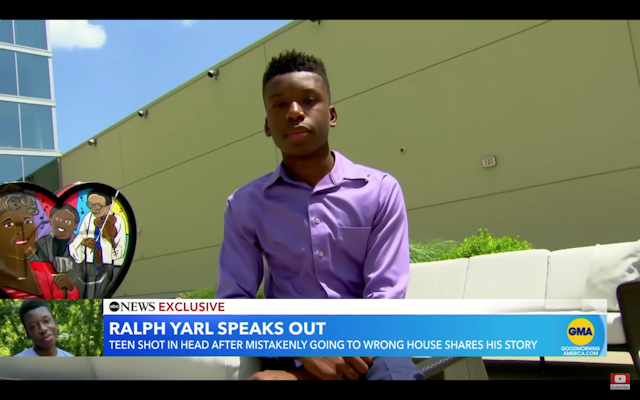Given the gunshot wounds to his head and arm, the fact that Ralph Yarl was able to celebrate his 17th birthday on May 7, 2023, is a modern-day miracle.
Less than a month earlier, on April 13, Yarl had gone to pick up his twin younger brothers from a play date in the Northland section of Kansas City, Kansas.
Instead of going to NE 115 Terrace, Yarl went a block away to NE 115 Street Place, where he rang the doorbell.
Within a few seconds after seeing Yarl at his door, the homeowner, Andrew Lester, an 84-year-old white man, fired his .32-caliber Smith & Wesson revolver and struck Yarl twice, once in his forehead and once in his arm.
No hesitation. No conversation. Yarl remembers Lester saying these five words before he shot him: “Don’t ever come here again.”
Eventually, Lester was charged with first-degree assault and armed criminal action, both of which are felonies. He was released after posting US$200,000 bail. On the assault charge alone, Lester faces a penalty of up to life in prison.
Local prosecutors have said there was “a racial component” to Yarl’s shooting. No hate crime charges have been filed against Lester.
Weeks after Yarl’s shooting, another incident involving neighbors occurred in Ocala, Florida, on June 3. But this one ended in the death of a 35-year-old Black woman, A.J. Owens.
In that case, Susan Lorincz, 58, a white woman, has pleaded not guilty to charges of assault and manslaughter with a firearm after reportedly shooting Owens after Owens rang her doorbell.
It is reported that Owens wanted to discuss the woman’s attacks on Owens’ children. Lorincz has claimed that she, too, feared for her life.
A long way from a colorblind society
In my book, Bodies out of Place: Theorizing Anti- blackness in U.S. Society, I describe how racist attitudes persist in society.
One way this happens is through fixed social ideas about where Blacks belong, when, with whom and in what position.
Any Black person outside of what someone else determines is his or her socially designated physical or social location is presumed to be out of place. In my book, I argue that the repercussions for being deemed “out of place” range from what some might call benign amusement to death. Make no mistake: Harm results in either case.
The shootings of Yarl and Owens are important to our national conversation about race and sense of place.
It hints at a reality that is both unpleasant and often ignored: Most Black people in American society are forced to navigate increasingly segregated spaces.

I argue that as Black people travel to, through and in spaces, the presumption of criminality shrouds their bodies. It follows them to work, school and play. To survive, Black people operate with a knowledge of beauty and precarity. For Black women, sociologist Patricia Hill Collins calls this consciousness an awareness of our status as “the outsider within.”
“Scared to death”
Like Owens’ shooter, Lester said he feared for his life and was only protecting himself when Yarl rang the doorbell. Through his attorney, Lester further said he was scared to death and thought Yarl was a burglar.
Because most would-be burglars do not ring doorbells, it’s fair to question on what he based his fear.
By all accounts, Yarl was a gifted young man before the shooting.
Meara Mitchell, a teacher of Yarl’s for several years, described him as a “stellar human being” with a “quiet fortitude.”
Yarl still has dreams of continued academic achievement, despite experiencing frequent headaches and other mental illnesses as a result of the gunshot wound.
During an interview on “Good Morning America,” Yarl told host Robin Roberts: “I’m just going to keep doing all the stuff that makes me happy. And just living my life the best I can, and not let this bother me.”
It boggles the imagination that the shooting would not bother Yarl. What is clear is that he is resolved – at least publicly – to not let it steal his joy.
As Elaine Nichols wrote for the National Museum of African American History and Culture, “Black Joy is and has been an essential act of survival and development.”
And as is often the case, the ability to feel great joy is only possible for those who have also known great pain.
Racism operates on a continuum
In its guidebook Race and Racism in the United States, the American Sociological Association describes how racism operates on the structural and individual level.
There are often expectations about who belongs in certain spaces. As the work of sociologist Nirmal Puwar demonstrates, physical spaces are gendered, raced and classed.
In Space Invaders: Race, Gender and Bodies Out of Place, Puwar aptly describes the way women and ethnic minorities are perceived as “space invaders” in comparison to white men who are perceived to belong.
Some have called Yarl’s shooting the “wrong door” case.
In my view, that characterization trivializes what happened.
As Yarl’s aunt, Faith Spoonmore, explained, he was “shot in the neighborhood where he lived.”
Kansas City resident Michele L. Watley called her city a place where “this veil of nicety and smiles … overlays microaggressions and all kinds of crazy stuff.”
Sociologist Eduardo Bonilla-Silva notes that colorblindness has been “the dominant racial ideology of the post–Civil Rights era.”
That ideology maintains that race no longer matters for people’s life chances.
But as Supreme Court Justice Ketanji Brown Jackson cogently wrote in her dissent in the Students for Fair Admissions v. University of North Carolina, “Deeming race irrelevant in law does not make it so in life.”
Just ask the families of A.J. Owens and Ralph Yarl.

